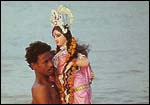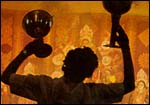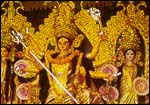
Welcome Devi Durga
... Calcutta whoops it up
Sriparna Ray
 The monotonous rains have stopped rattling on your rooftops. The sun has come out with a new shine. And monsoon has given way to autumn, an Indian autumn, a kind of non-season before winter. However, for Bengalis, it is not merely a change of season. For them, the advent of autumn signifies the arrival of the festive season. Durga Puja their biggest and merriest festival is only a few days away.
The monotonous rains have stopped rattling on your rooftops. The sun has come out with a new shine. And monsoon has given way to autumn, an Indian autumn, a kind of non-season before winter. However, for Bengalis, it is not merely a change of season. For them, the advent of autumn signifies the arrival of the festive season. Durga Puja their biggest and merriest festival is only a few days away.
The streets are full of happy confusion. Plenty of hustle and bustle. The shops are overflowing. Folks are busy buying, buying, buying. Saris -- vibrant tant ones, elegant kantha-worked ones. Sweets. Plump rasgollas. Creamy sandesh. Outfits for kids. Gifts for themselves as well as for all at home. Exchanging gifts is a popular custom during Durga Puja. As is getting togged out in your Puja day best. It is a colourful time.
Pandals, that will house straw and mud idols of the fierce and voluptuous Durga riding her pet lion, are erected at almost every nook and corner. Brightly coloured cloth is used to decorate pandals which often bear a semblance to some notable building or fancy monuments or they may be built like a haughty temple. Or simply a house.
However, Durga Puja has not always been a Baroari puja -- as a puja is termed when performed together by a group of people. Earlier, rich families would perform the puja privately in their homes. However, due to the lack of space and with the emergence of nuclear families, this kind of practice has become rare. A new form of ceremony evolved which came to be known as Baroari Puja, Etymologically, the term baroari has been derived from the phrase baro yaar (which mean twelve friends). Twelve friends had originally got together to celebrate Durga Puja and ever since it has become a ceremony that is celebrated collectively.
The idol of Durga is flanked by the idols of Lakshmi, Saraswati, Kartik and Ganesh, all of whom are believed to be her children. The goddess sits atop a lion which is her vahan. The favourite tableaux is of her stabbing Asura, the demon. It is symbolic of the victory that she had achieved for the gods over the demons. As the myth goes, the demons or the Asuras had usurped the heavenly kingdom of the gods. The gods were helpless as to how they could get their kingdom back. They approached Brahma, the god of all creations who created for them a goddess, who possesses all the powers in the world. Durga, who is the goddess of shakti, defeated the demons and restored the kingdom that rightfully belonged to the gods.
 Besides being the warrior figure, she also symbolises the figure of the mother for every devout Bengali and also that of a daughter. The five days through which the puja lasts were seen as the occasion when the goddess visits her parents' house. She becomes every man's married daughter and she is everyman's mother too. In her, the three images of warrior, mother and daughter are juxtaposed. Besides being the warrior figure, she also symbolises the figure of the mother for every devout Bengali and also that of a daughter. The five days through which the puja lasts were seen as the occasion when the goddess visits her parents' house. She becomes every man's married daughter and she is everyman's mother too. In her, the three images of warrior, mother and daughter are juxtaposed.
Traditionally, the idols of Durga, Lakshmi, Saraswati, Kartik and Ganesh are erected within one frame which is known as ekchala. However, this has undergone a change and in many places, the different idols are erected in separate frames. The gods and goddess, are adorned in gorgeous, EM>jhatak attire and ornaments. But, the traditional custom of dressing up the images in richly ornate pith work, is also followed in certain places.
Durga is known by various names of which one is Dashabhuja or one with ten arms. She carries a weapon in each hand and its signifies the menacing assimilation of power that Brahma had blessed her with.
But this image of the goddess has also undergone transformation in different parts of Bengal and various myths have been linked to these different forms that the goddess has been given. For instance, in Raghunathganj in the district of Murshidabad, Durga has an incision on her stomach. The prevalent myth here is that once, on the ninth day of the puja, the goddess had swallowed a young girl alive. That night, the priest dreamt of this phenomenon and immediately went to retrieve the girl by cutting the stomach of the goddess. Miraculously the girl was still alive. Since then, the image of the goddess erected there has always had a cut on her stomach.
In Jalpaiguri, an idol is created whose body is painted in the colour of blood. She also has both a lion and a tiger as her vahans. In yet another place, in the village of Sripur, Durga sits atop neither a lion nor a tiger, but quite amazingly, a dragon.
Even though Durga Puja is celebrated over a period of five days, it actually lasts for many more days. The earliest reference of the invocation of Durga is found in the Ramayana in Brihaddharmpurana written in the thirteenth century, where Ram had invoked the goddess to achieve victory over Ravana.
The Puja commences from Mahalaya which is the first of the ten days that the ritual lasts. However, the celebrations begin only from the sixth day which is known as Shashthi. The goddess is welcome on this day. The next day is called Shapthami. Ashthami, the eighth day, is central to the festival. In the morning, offerings are made to the goddess with fervour, by young and old alike. The large numbers that flock the pandals on this day can be seen devoutly repeating mantras that the priest utters aloud and clutching flowers in their hands that they are supposed to offer at the goddess' feet.
At the juncture of the eighth and ninth day (Nabami) the Sandhi Puja is performed. This ritual has its origins in the Ramayana. Goddess Chandi had prophesied that Ravana's head would roll when the eighth day would end and the ninth day would begin. This juncture is known as Sandhi. Hundred and eight oil lamps and the same number of lotuses are the main ingredients of the Puja.
 Dashami (the tenth day) marks the culmination of the celebrations that have been on for almost a week. On this day married women apply sindoor or vermilion on each other's forehead. In the evening, the goddess is bid farewell. Her idol is immersed in the river which is a long drawn ritual. Delirious crowds accompany the goddess when she is taken to the river, usually on a decorated truck. The drums or dhak that are an integral part of the ceremony throughout the five days, are played rousingly. Amidst this mood of gaiety, there is also a touch of sadness as the goddess returns to her husband's home. Dashami (the tenth day) marks the culmination of the celebrations that have been on for almost a week. On this day married women apply sindoor or vermilion on each other's forehead. In the evening, the goddess is bid farewell. Her idol is immersed in the river which is a long drawn ritual. Delirious crowds accompany the goddess when she is taken to the river, usually on a decorated truck. The drums or dhak that are an integral part of the ceremony throughout the five days, are played rousingly. Amidst this mood of gaiety, there is also a touch of sadness as the goddess returns to her husband's home.
During the five days of the festival, crowds pour in at every pandal throughout the day and especially in the night. Teeming millions throng the puja pandals to get a glimpse of the brilliantly innovative lighting that illuminate the entire city.
Calcutta being such a cosmopolitan city, people from all communities join in the celebrations with equal zeal as the Bengalis. Yet, it cannot be denied that Devi Durga is the icon of Bengali culture. Through this festival, the Bengalis somewhere seek a sense of community. The celebration is a kind of assertion of their identities as Bengalis. And, this is precisely the reason why Durga Puja is celebrated not only throughout the country but all over the world by Bengalis with great vigour, reverence, joy and most importantly, pride.
|



